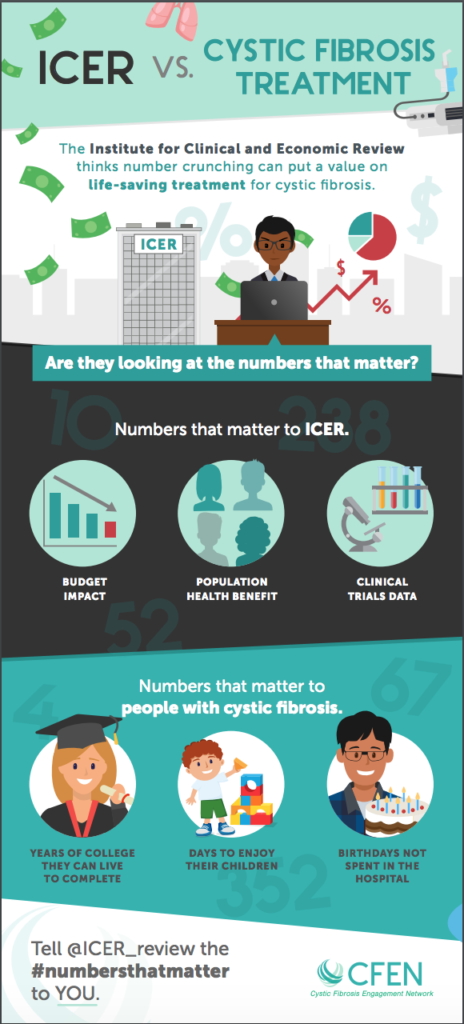The Institute for Clinical and Economic Review (ICER) is back at it again. Just last week, the not-so-independent watchdog for all things drug coverage in the United States released its draft report for “Modulator Treatment for Cystic Fibrosis: Effectiveness and Value.”
As a refresher, ICER uses a mathematical model called Quality-Adjusted Life Years (QALY) to determine whether medications are worth their value. QALY is a somewhat complex algorithm that assigns utility values to people living with various conditions. To answer your question… the group of bioethicists (is bioethics even a real profession? Sounds like a made up job to me), use QALY to assign a value to your life before and after you are treated with a specific medication to figure out what sort of value the medication should hold. In this case, ICER is evaluating the modulator therapies in cystic fibrosis.
QALY is the exact model that led to the deadly delay in modulator access for people living with cystic fibrosis in the United Kingdom. A similar model is still contributing to the ongoing situation in Canada. As a reminder, Orkambi and Symdeko are STILL not widely available north of the boarder.
The crux of the utility calculation is a formula that predicts mortality for a given age and state of health. The function is evaluated against a baseline risk of mortality across the entire US population. It is then compared to the utility calculation after a medication is applied to the patient. The cost of the gain in health through the price of the drug is then evaluated against different cost-effectiveness thresholds. The cost function isn’t exactly a fun thing to look at, but if you want to give it a shot for your life… here you go:
𝐾 = 0.15(SEX − 0.47) − 0.042(ppFEV1 − 67.7) − 0.0280(WFA + 0.85) + 0.350(#PE− 1.1) + 0.440(DIAB − 0.061) − 0.140(PS − 0.053) + 1.410(BAI − 0.032) − 0.280(#PE − 1.1)(BAI − 0.032)
Where SEX = male (0) or female (1), ppFEV1 = %FEV, WFA = weight for age z score, #PE = # of acute pulmonary exacerbations in the current year, DIAB = diabetes (0 = no, 1 yes), PS = pancreatic sufficiency (0 = no, 1 = yes), BAI = B. cepacia culture (0 = no, 1 = yes).
The formula is found on page 64 of the draft report along with instructions for calculating a mortality rate. Of note, cepacia infections and pulmonary exacerbations are weighted quite heavily in the function, which is something most of us would actually agree with. The function very clearly, however, leaves out the intangibles of life itself… like, you know, the simple pleasures of living.
It’s for that reason I called QALY, “discriminatory and ableist” in an op-ed in The Hill. QALY simulations directly discriminate against people living with terminal (yet-to-be-cured) illness because we cannot return to a state of full health despite living through remarkable recoveries – in this case, Trikafta’s health benefit. Yes, it’s true we cystic fibrosis will likely be the contributing factor to our demise as patients, despite all the progress, but that’s not to say that we can’t live full, successful lives. I feel just as valuable to society as my friends, peers, classmates, colleagues and any one else. The mortality function above doesn’t capture my journey from near end-stage illness to surviving and moving on with my life. I can’t help but look at that mortality function and laugh.
In a way, I feel validated. Just about two weeks ago, the Pioneer Institute released a public policy paper in which they found that QALY violates the Americans with Disability Act.
From the paper:
“QALY has the potential to unlawfully discriminate against disabled or chronically ill persons who may never experience full restoration to a certain quality of life defined by QALY. Consequently, the QALY methodology may cause Medicaid programs to have a disparate impact, or discriminatory effect, on disabled persons. Disparate impact could stem from QALY assigning lower values to treatments for disabilities; thus, rendering them less available to those whom they benefit.” (Pg. 8)
Further, the National Council on Disability, an independent federal agency, has come out and said that it is critical that QALY calculations are not used in determining access to care.
It is worth noting that ICER doesn’t actually possess any legal power, but that has not stopped insurers and Medicaid agencies from citing QALY calculations. None of their reports can, however, determine law like QALY calculations do in other countries around the world. It is essential QALY doesn’t seep into the United States health industry. If it does, people with rare terminal illness could be the first to feel its power. For that reason, join me and other cystic fibrosis patient advocates in bringing our message to ICER’s doorstep. In conjunction with Cystic Fibrosis Engagement Network we want you to tell ICER what numbers matter to you! See the info graphic below to see how you can help, and remember to use the hashtag, #numbersthatmatter





